文章目录
1.单继承中的虚函数表整体代码用程序打印虚表如何寻找到虚表地址虚表存在哪里? 2.多继承中的虚函数表整体代码寻找虚表地址注意事项多继承重写后的func1地址为什么不同?ptr1调用函数——一次jmpptr2 调用函数——多次jmp
1.单继承中的虚函数表
整体代码
#include<iostream>using namespace std;class Base{public: virtual void Func1() { cout << "Base::Func1()" << endl; } virtual void Func2() { cout << "Base::Func2()" << endl; } void Func3() { cout << "Base::Func3()" << endl; }private: int _b = 1;};class Derive : public Base{public: virtual void Func1() { cout << "Derive::Func1()" << endl; } virtual void Func4() { cout << "Base::Func4()" << endl; }private: int _d = 2;};typedef void(*VF_PTR)(); // typedef void(*)() VF_PTR;void PrintVFTable(VF_PTR table[])//函数指针数组{ int i = 0; for (i = 0; table[i] != nullptr; i++) { printf("[%d]:%p\n",i, table[i]); VF_PTR f = table[i]; f(); }}int main(){ Base b; Derive d; PrintVFTable((VF_PTR*)*(int*)&b); cout << endl; PrintVFTable((VF_PTR*)*(int*)&d); return 0;}在子类中实现一个虚函数Func4,但是不构成重写

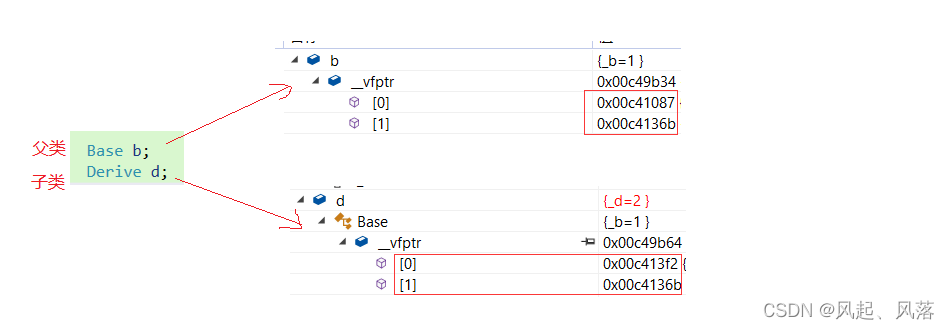
Func4函数并没有进入虚表中

通过查询内存发现,虚表指针中存在三个地址,而其中两个正好为监视中的两个地址
猜测 0x00c4146a 就是Func4的地址
用程序打印虚表
虚表本质是一个函数指针数组
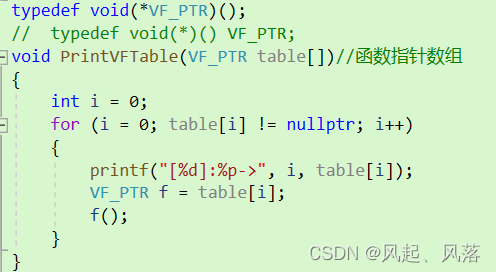
VS中在数组最后放了一个nullptr,这样就可以解决在不同虚表中的个数不同的问题

typedef一个函数指针 为VF_PTR
正常来说 要写成将VF_PTR放在后面

但是由于函数指针的特殊性,定义变量都要放在中间
如何寻找到虚表地址
想要虚表的地址,就可以通过找到虚表的指针
而这个虚表指针在对象中,这个指针在对象的前4个(32位)或者8个字节(64位)上面
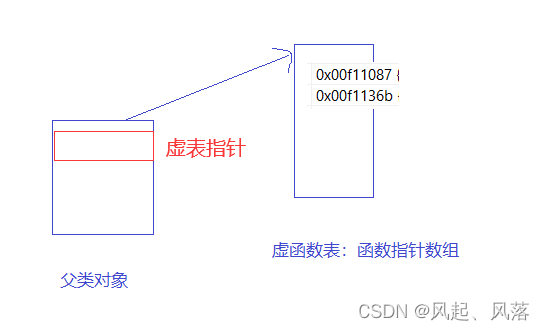
以32位为例,如何取对象的前4个字节
强制转换为int*
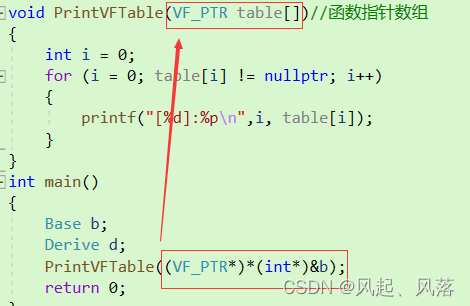
* (int* )&b
首先取到Base* ,将其强制转换为int*,代表前四个字节的地址,再解引用是int类型,把前四个字节取出来
但是由于PrintVFTable函数参数是 函数指针数组
(VF_PTR*) * (int *)&b
如果这个数组是int类型,就需要 一个int * 指针去指向
同理 ,该数组为 VF_PTR类型,需要一个VF_PTR *指针去指向
所以需将 int 类型 再次强制转换为 VF_PTR * ,使其指向这个数组
缺陷
但是这种写法具有一定的局限性,只能在32位跑,因为32位指针大小为4个字节
而64位下就不行了,64位下指针大小为8个字节

运行程序打印虚表,确实了解到多了一个地址
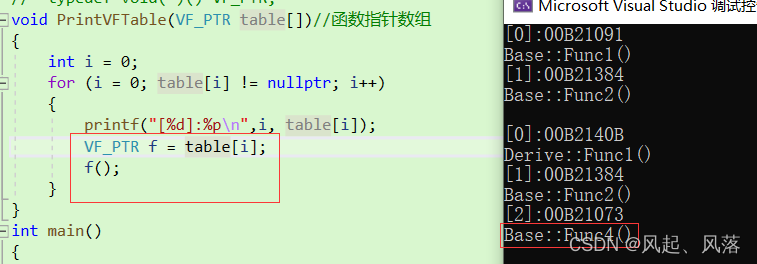
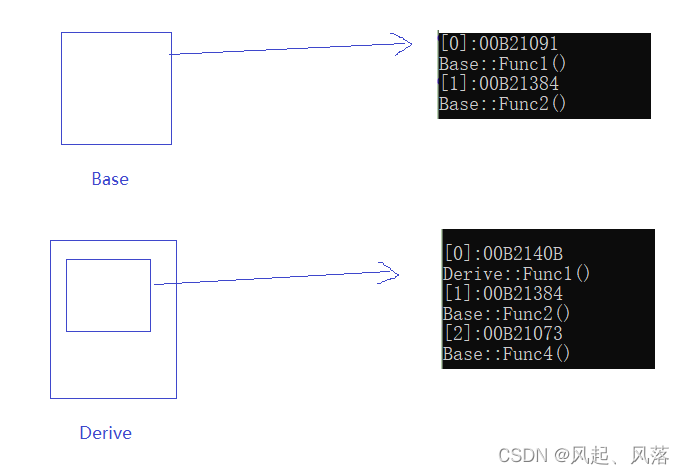
把虚表的地址拿出来赋给函数指针,用函数指针去调用函数
这里发现 监视中没有出现的地址确实是Func4函数的地址
虚表存在哪里?

由于常量区地址与虚表的地址最为接近,所以说明虚表在常量区/代码段上
2.多继承中的虚函数表
整体代码
class Base1 {public: virtual void func1() { cout << "Base1::func1" << endl; } virtual void func2() { cout << "Base1::func2" << endl; }private: int b1;};class Base2 {public: virtual void func1() { cout << "Base2::func1" << endl; } virtual void func2() { cout << "Base2::func2" << endl; }private: int b2;};class Derive : public Base1, public Base2 {public: virtual void func1() { cout << "Derive::func1" << endl; } virtual void func3() { cout << "Derive::func3" << endl; }private: int d1;};typedef void(*VF_PTR)(); // typedef void(*)() VF_PTR;void PrintVFTable(VF_PTR table[])//函数指针数组{ int i = 0; for (i = 0; table[i] != nullptr; i++) { printf("[%d]:%p->", i, table[i]); VF_PTR f = table[i]; f(); }}int main(){ Derive d; PrintVFTable( (VF_PTR*) *(int*) &d); cout << endl; /*PrintVFTable((VF_PTR*)*(int*)( (char*)&d+ sizeof(Base1) ) );*/ Base2* ptr2 = &d; PrintVFTable((VF_PTR*)*(int*)(ptr2)); return 0;}寻找虚表地址
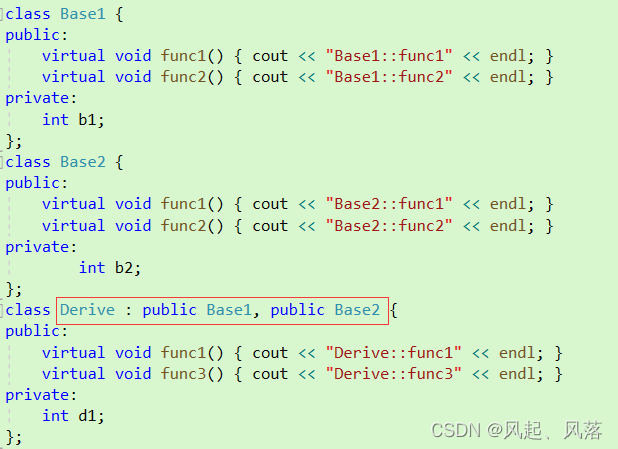
Derive 作为Base1 和Base2的子类,所以Derive内部有两张虚表
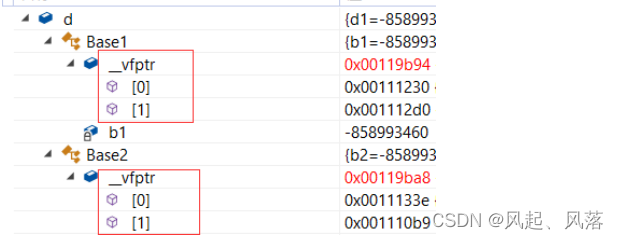
正常来说,Derive内部还存在一个func3函数,这个函数放在哪里了呢?
借助打印虚表来查看,这里的打印虚表依旧可以使用单继承中的那个
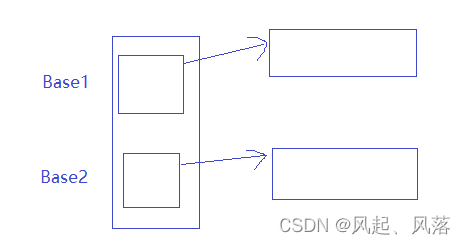

base1的虚表指针 正好在对象的前4个字节处,直接可以使用求出虚表指针 去指向base1的虚表
方法1 : base2的虚表指针 需要加上base1的大小

但是这里要注意一个问题,若写成 PrintVFTable((VF_PTR*)(int)( &d+ sizeof(Base1) ) )
写的并不对,d本身是一个Derive类型,&d后变为Derive* 的一个指针,+1 跳转的是Derive类型的字节大小
而该设计想要每次+1跳转1个字节,所以需要强制转换char*
方法2 :切片自动偏移

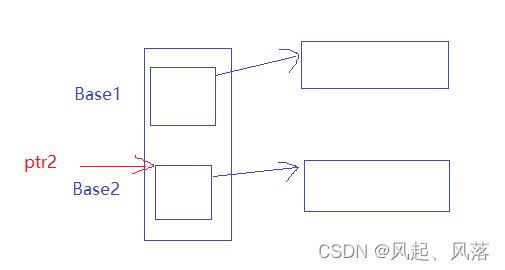

两种方法的结果都是一样的
注意事项
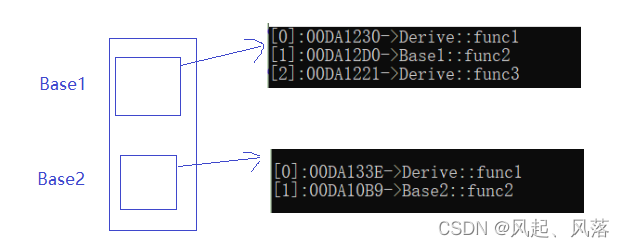
多继承派生类增加的的虚函数在第一个虚表中
多继承重写后的func1地址为什么不同?

ptr1调用函数——一次jmp
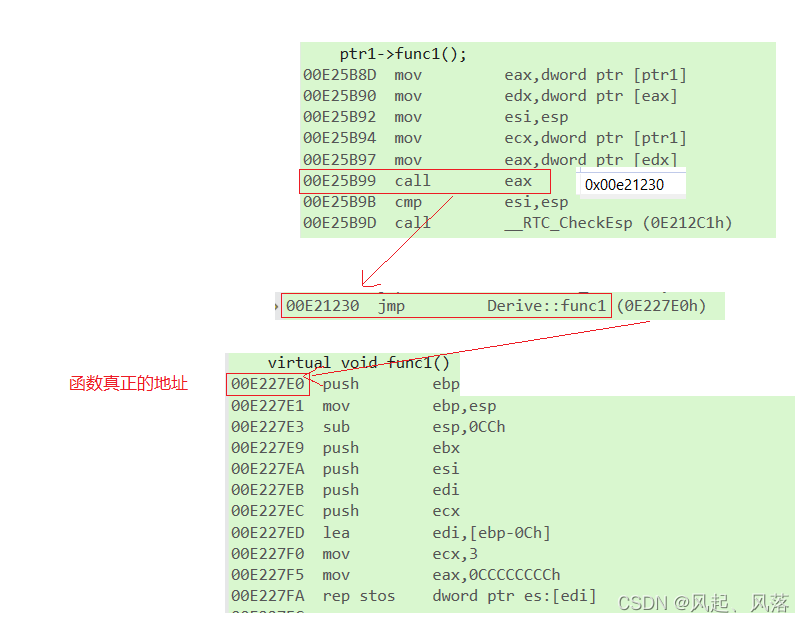
找到 Base1虚表里的地址 0x00e21230 ,再call这个地址
只需要jmp一次 就可以找到实际真正执行的函数地址
ptr1调用地址属于正常调用
ptr2 调用函数——多次jmp
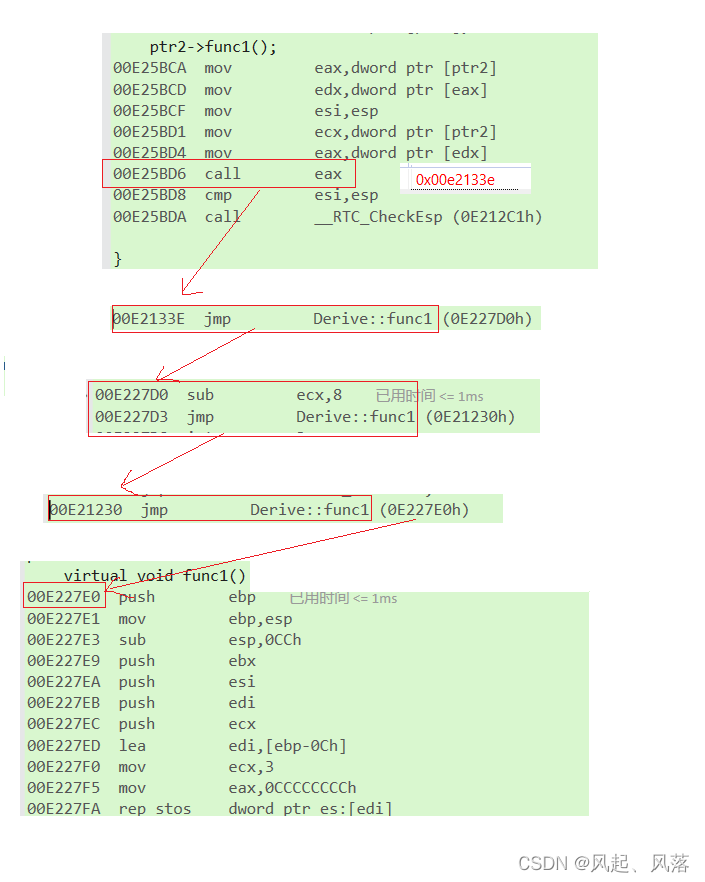
ptr2调用地址,需要 多次jmp 才能找到真正的函数地址

ecx存的是this指针
ecx,8 目的是修正this指针的位置
最终Base1和Base2都是执行同一个函数的指令
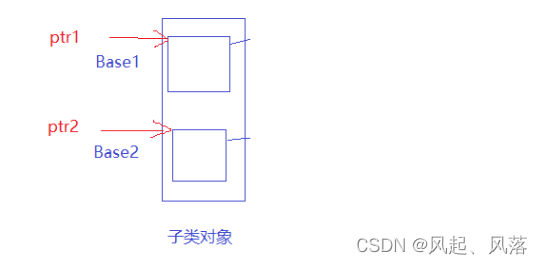 ptr1->func1 调用的是子类的func1函数,ptr1指向调用对象的开始ptr2并没有指向子类对象的开始,此时调用子类对象的func1函数,this指针指向中间的位置不对了,所以需要修正this指针,使之指向子类对象开始的地方
ptr1->func1 调用的是子类的func1函数,ptr1指向调用对象的开始ptr2并没有指向子类对象的开始,此时调用子类对象的func1函数,this指针指向中间的位置不对了,所以需要修正this指针,使之指向子类对象开始的地方